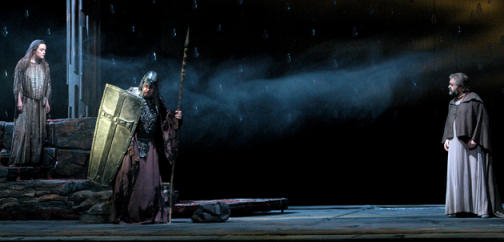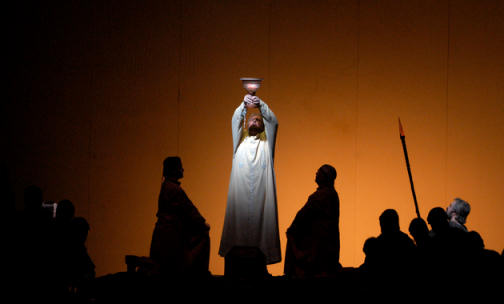Other Links
Editorial Board
-
Editor - Bill Kenny
-
Deputy Editor - Bob Briggs
Founder - Len Mullenger
Google Site Search
SEEN AND HEARD
INTERNATIONAL OPERA REVIEW
Wagner, Parsifal:
Soloists, Chorus and Children’s Chorus of the Dresden State Opera, Sinfoniechor
Dresden, Sächsische Staatskapelle Dresden, Lothar Zagrosek (conductor).
Semperoper, Dresden, 13.4.2009 (MB)
1988 must have been a good year for Wagner in Dresden, since the Staatsoper
premiered not only
Wolfgang Wagner’s Dutchman but also Theo
Adam’s Parsifal. In truth, neither production has a great deal to say to
a contemporary audience, if indeed either did at the time. The prospect of an
East German Parsifal was intriguing but there are no political statements
here. What we have is a straightforward, uncontroversial telling of the story.
Scenery and costumes are more or less as one would expect, with the partial
exception of a peculiarly unattractive magic garden for Klingsor, likewise the
strange, butterfly-like costumes for the Flowermaidens. As with Wolfgang
Wagner’s Dutchman, we see pretty much everything we should. In this case,
the Grail looks like the Grail and is elevated by Parsifal in the final scene.
The spear looks like a spear and does what it should. The most fanatical
adherent to Wagner’s stage directions might lament the lack of a dove at the
end, but otherwise would have little with which to find fault. Parsifal does not
himself make the sign of the Cross at the end of the second act but a Cross is
revealed in the sky, thereby avoiding the nonsense that many productions suffer
when he speaks of something that is merely disregarded. However, it was not at
all clear what its presence meant, given the lack of any overt Christian or
indeed anti-Christian reading of the work: probably better than disregard, but
not preferable to dramatically underlined absence, as in Nikolaus Lehnhoff’s
Waste Land ‘heap of broken images’ production for the English National
Opera.
Stefan Herheim’s Bayreuth Parsifal
remains utterly in a class of its own. One thing, however, that distinguished
this production from the previous night’s Dutchman was the role of Heidi
Stock as acknowledged revival director. Her material might not have been the
most inspiring but she ensured that the cast, including the chorus, knew what it
should be doing rather than being left to fend for itself. A nice touch, whether
hers or Adam’s, was to have the brothers all turn away from Amfortas upon his
first act pleas for mercy.
Amfortas – Hans-Joachim Ketelsen
Titurel – Jacques-Grel Belobo
Gurnemanz – Matti Salminen
Parsifal – Stig Andersen
Klingsor – Thomas Jesatko
Kundry – Lioba Braun
Flowermaidens – Christiane Hossfeld, Birgit Fandrey, Annette Jahns, Roxana
Incontrera, Sabine Brohm, Elisabeth Wilke
Knights of the Grail – Gerald Hupach, Jürgen Commichau
Squires – Angela Liebold, Sofi Lorentzen, Tom Martinsen, Matthias Henneberg
Voice from Above – Sofi Lorentzen
Theo Adam (original director)
Heide Stock (revival director)
Rolf Langenfass (designs and costumes)
Chor der Sächsichen Staatsoper Dresden
Gentlemen’s voices from the Sinfoniechor Dresden
Kinderchor der Sächsischen Staatsoper Dresden
Matthias Brauer and Ulrich Paetzholdt (chorus masters)

Greater weight was placed upon the Transformation Music and upon the choral
sections, here superbly rendered by the assorted choruses, of whom the excellent
children’s choir merits special mention. The work of Matthias Brauer and Ulrich
Paetzholdt had clearly paid off. Likewise, the Staatskapelle Dresden was once
again on splendid form. There may be no one ‘right’ sound for Wagner, but this
orchestra is certainly one of the best equipped tonally for his music. The
strings truly glowed, whilst the woodwind added piquant colour. At climactic
moments, the brass made its presence felt without the slightest sense of Solti-like
crudeness. The excellent timpanist’s role in dramatic punctuation was of the
highest importance. There were a few instances of insecurity, such as a wrong
entry from the woodwind immediately prior to Parsifal’s baptism of Kundry. For a
worrying moment, it sounded as though the orchestra might have lost its way, but
Zagrosek pulled his forces together.

This brings me to the singers. Parsifal is a less fiendish role than Tristan or
Siegfried, for which one might read that it is not simply impossible.
Nevertheless, it is hardly an easy ride. Stig Andersen did a highly creditable
job, even managing to seem vaguely plausible as the foolish boy of the first
act, if without the success in this respect of
Stefan Vinke in Leipzig a week earlier. Lioba
Braun was an excellent Kundry. She was perhaps less impressive as the seductress
of the earlier part of the second act but gave a memorable portrayal of unhinged
reaction to Parsifal’s rejection of her kiss. Like her character, she hurled
everything into her efforts to change him. Matti Salminen was slightly
disappointing earlier on, most uncharacteristically subdued; however, his tone
garnered richness and authority a little way in to his third act scenes. Thomas
Jesatko was thrillingly malevolent as Klingsor, perhaps more so than he had been
at Bayreuth, although there the production had more than made up for it.
Hans-Joachim Ketelsen was a more than acceptable Amfortas; I had probably been
spoiled by the astounding portrayal offered by
Tumoas Pursio for Oper Leipzig. The Flowermaidens were a mixed bunch, as it
were. Sadly, those who looked unusually ‘mature’ sounded somewhat past their
best too, although there were clearly some good voices amongst the group.
Mention should also go to a splendid Voice from Above in the guise of Sori
Lorentzen. All in all, then, this was a rather successful Parsifal, at
least in musical terms.
Pictures © Matthias Creutziger
Back
to Top
Cumulative Index Page
